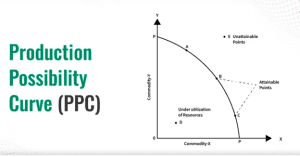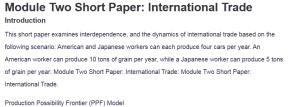Module Two Short Paper: International Trade
Introduction
This short paper examines interdependence, and the dynamics of international trade based on the following scenario: American and Japanese workers can each produce four cars per year. An American worker can produce 10 tons of grain per year, while a Japanese worker can produce 5 tons of grain per year: Module Two Short Paper: International Trade: Module Two Short Paper: International Trade.
Production Possibility Frontier (PPF) Model
| Workers Needed to Make | ||
| One car | One ton of grain | |
| The U.S. | 25 million | 10 million
|
| Japan | 25 million | 20 million |
Table 1
Source: Smith & Landry (2021)
A production possibility frontier (PPF) graph demonstrates the trade-offs an economy faces when allocating limited resources between the production of two goods or services. Essentially, the curve represents the maximum possible output combinations that could be attained while utilizing current resources and thus, illustrating efficiency when production occurs on the curve itself (Mankiw, 2024). Notably, points inside the curve indicate inefficiency which connotes a situation where resources are underutilized, while points outside the curve cannot be attained without economic growth.
Opportunity Cost
| Opportunity Costs Of | ||
| One car (in terms of tons of grain given up) | One ton of grain (in terms of cars given up) | |
| The U.S. | 2.5 tons of grain | 0.4 cars |
| Japan | 1.25 tons of grain | 0.8 cars |
Table 2
Interdependence and Gains From Trade
Given that it can produce 10 tons of grain as opposed to Japan’s 5 tons, the United States has an absolute advantage in this regard. On the other hand, automotive productivity is the same in both nations. Japan has a comparative advantage in the manufacture of cars (lower opportunity cost), whereas the United States has a comparative advantage in the production of grains (lower opportunity cost). Considering a case of no trade when half of the workers in each country produce cars and the other half produces grains, the two countries will have the following production.
United States
0.25 cars × 50 million workers = 12.5 million cars
10 tons × 50 million workers = 500 million tons of grain.
Japan
0.25 cars × 50 million workers = 12.5 million cars
5 tons × 50 million workers = 250 million tons of grain.
Arguments for Trade
In their article, “The Benefits of Free Trade: Addressing Key Myths” Boudreaux & Ghei (2023) vehemently support free trade agreements by outlining their many advantages and dispelling widespread myths. The authors contend that by giving customers access to a wider range of products and services at reduced costs, free trade improves economic development for participating countries.
Increased efficiency and competitiveness in international marketplaces are the causes of this improvement in customer choice and affordability. Notably, the discussion below emphasizes how free trade agreements establish a framework that supports the mentioned circumstances, allowing countries to make use of their comparative advantages and increase economic output in general.
Economic performance is one of the main positive effects of free trade as advocates promote this concept and policy. According to the authors, free trade means costs of production are lowered particularly by the opportunity to import inputs from other markets. Much of these imports, for instance, are intermediate inputs for domestic producers, which directly cuts production costs and boosts economic activity. Thus, free trade also brings value for resources to be redirected to more productive sectors, which in turn elevates innovation standards of living and wages paid.
While protectionism tends to perpetuate ineffectiveness in organizations because they are shielded from what competition entails, FTAs would help create and sustain a vibrant and competitive economy because industries are prompted to compete for globalization. Notably, this flexibility is good for long-term development. Further, the article argues that trade liberalization leads to the formation of opportunities and the maintenance of economic growth.
The article also addresses the issue of equity and neutrality in the framework of free trade agreements. It notes that standard-setting systems such as those contained in trade treaties minimize the propensity for cronyism and obnoxious trade practices. In this way, such agreements guarantee that all parties involved stick to legal provisions that provide the best chance of driving improvements by competition. On the other hand, protectionism is normally marked by protecting certain industries at the cost of others, which is normally characterized by inefficiencies and high costs to the consumers.
For instance, the authors use the case of the steel industry by noting that tariffs raised the costs for downstream industries that provide jobs for far more workers than just the steel companies. These persisting problems are, however, reduced by the FTA as they support fair trade which is good for the overall economy.
Finally, to buttress their arguments for free trade, the authors debunk myths related to trade deficits, sovereignty, and jobs. In addition, they pointed out that trade deficits are not necessarily bad signs but rather reflect confidence in the stability of the nation’s economy. Petroleum dollars going outside the U.S. come back as capital investments that create employment and enhance inventive activities and productivity.
Regarding sovereignty, the authors state that trade agreements increase freedom and do not reduce it since they create cooperative structures not to allow for perilous protectionist measures. About employment, the article notes that many shifts in the labor force stem from technological advancement, not trade. FTA, hence, is not a cause for job removal but rather a way of identifying better-paying occupations.
In a nutshell, the article provides the necessary arguments and evidence that free trade agreements are beneficial to economic development efficiency, and fairness, and free from myth that surrounds it. Hence, the article strongly underscores the fact that trade liberalization brings more dynamism, competition, and equity into international operations and shields consumers negatively from the vagaries of protectionism regimes. Given that misconceptions exist, and the virtues of free trade’s benefits are painted in the broad strokes of a few points, the authors give a solid case for free trade’s imperative status in the contemporary international trade arena.
Drawing from a related article titled ” The Evidence for Free Trade and Its Background Assumptions: How Well-Established Causal Generalizations Can Be Useless for Policy” by Luis Mireles-Flores (2022), various arguments in favor of free trade agreements are identified. Unlike some critics of free trade agreements, the article subscribes to the convergence of views held by economists on the expected gains from trade liberalization. Mireles-Flores does not challenge this proposition that escalating trade liberalization facilitates increased efficiency, growth, and invariably enhanced consumer welfare.
Rather he provides demolitions of many of the studies that use such effects as the measures of these aspects, pointing out that these are problems of method, from inadequate definitions of free trade to research that is not anchored in place and time well enough to be of policy-use. Notably, this means that by encouraging better research, the article indirectly supports the theoretical paradigm of trade liberalization because the demand for accuracy stems from the conviction that better data can much more efficiently justify the necessity of free trade agreements.
The article reaffirms the need for some more context of trade liberalization operating, to stand in agreements for certain particular circumstances of economic and social environment. Mireles-Flores (2022) also dismisses the tendency among free trade proponents to advance generalizations based on case study research. In promoting more context-sensitive research, the article supports a perception that appropriately designed free trade arrangements, aligned to the distinctive characteristics of the economy of the respective parties are likely to deliver intended gains. These trends, along with a commitment to work with local stakeholders to develop custom-tailored trading environments, help underscore the notion that FTAs can be great sources of economic growth.
Additionally, the article contributes to the understanding of free trade by dispelling the myths and oversimplification that may be underlying the trade liberalization opposition. The methodological assumptions described by Mireles-Flores (2022) should be a helpful addition in responding to critics who express doubt concerning free trade empirical evidence due to its questionable quality. By enhancing the quality of the rationale for free trade the article assists in mitigating political support for the carefully constructed and empirically backed free trade agreements.
Although Mireles-Flores’s article provides a disappointing criticism of the methodological premises of empirical research on trade liberalization, it nonetheless speaks indirectly in favor of free trade agreements by urging the observation of better materials for the realization of these agreements. Recognizing the theoretical gains from free trade, the article underlines the need for further research of higher methodological quality and greater attention to the contexts within which policies are being implemented.
References
Boudreaux, D. J., & Ghei, N. (2023). The Benefits of Free Trade: Addressing Key Myths. INTERNATIONAL FREEDOM AND TRADE. https://www.mercatus.org/research/policy-briefs/benefits-free-trade-addressing-key-myths
Mankiw, N. G. (2024). Principles of economics (10th ed.). Cengage.
Mireles-Flores, L. (2022). The evidence for free trade and its background assumptions: How well-established causal generalizations can be useless for policy. Review of Political Economy, 34(3), 534-563.
Smith, T. A., & Landry, C. E. (2021). Household food waste and inefficiencies in food production. American Journal of Agricultural Economics, 103(1), 4-21.
ORDER A PLAGIARISM-FREE PAPER HERE
We’ll write everything from scratch
Question
ECO 202 Module Two Short Paper Guidelines and Rubric
Scenario
For this assignment, assume that American and Japanese workers can each produce four cars per year. An American worker can produce 10 tons of grain per year, while a Japanese worker can produce 5 tons of grain per year. To keep things simple, assume that each country has 100 million workers.
Directions
Using the template provided in the What to Submit section, develop a short paper analyzing the international trade dynamics of the scenario above. Support your answers with sources from the textbook and your own research.
Specifically, address the following:
- Production Possibility Frontier (PPF) Model
- For the United States, how many workers are needed to make one car? How many are needed to make one ton of grain? For Japan, how many workers are needed to make one car? How many are needed to make one ton of grain? Fill in Table 1 in the template. (See Figure 1 The Production Possibilities Frontier, Mankiw 3-1a: Production Possibilities for an example.)
- Insert a production possibilities frontier (PPF) graph from the textbook or a reputable online source (see the Supporting Materials section for tutorials on snipping images) and explain in two to three sentences what a PPF graph demonstrates and how it illustrates the idea of efficiency.
Module Two Short Paper: International Trade
- Opportunity Cost
- For the United States, what is the opportunity cost of a car? What is the opportunity cost of grain? For Japan, what is the opportunity cost of a car? What is the opportunity cost of grain?
- Fill in Table 2 in the template. (See Table 1 The Opportunity Cost of Meat and Potatoes, Mankiw 3-2b: Opportunity Cost and Comparative Advantage for an example.)
- Interdependence and Gains From Trade
- Which country has an absolute advantage in producing cars? Which country has an absolute advantage in producing grain?
- Which country has a comparative advantage in producing cars? Which country has a comparative advantage in producing grain?
- Without trade, half of each country’s workers produce cars, and half produce grain. What quantities of cars and grain does each country produce?
- Arguments for Trade
- Research a current news article on international trade that supports economists’ arguments favoring free trade agreements (FTAs). In what ways is the article supportive of FTAs?
This assignment was adapted from the textbook Principles of Economics (10th edition) by N. G. Mankiw (2024).
What to Submit
Template: Module Two Short Paper Template
Use this template to create and submit your short paper for grading. Sources should be cited according to APA style.



